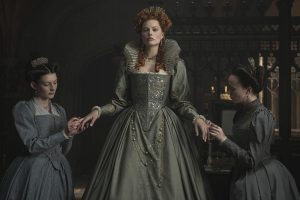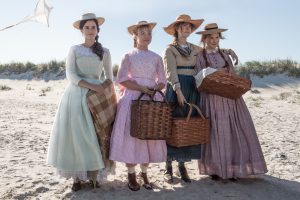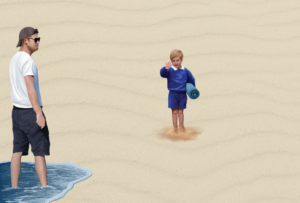Trigger warning: this article includes discussion of alcohol and substance abuse.
The Outrun (2024) is a study in contradiction. Simultaneously loud and overwhelmingly quiet, dreamlike and intensely grounded in reality, Saoirse Ronan shines as Rona—a young woman returning to her hometown after ninety days in rehab for alcohol abuse. Directed by Nora Fingscheidt, the film is based on Amy Liptrot’s 2016 memoir of the same name and provides cataclysmic glimpses into what it’s like to recover from addiction.
With Rona’s return to her hometown on the Orkney Islands—a sparsely populated archipelago off the coast of Scotland—after spending her early twenties in big-city London, The Outrun sets the tone through a stark contrast between the two places. The film is profoundly focused on the relationship between humans and nature, and provides a backdrop unlike what audiences might expect in a movie about alcoholism. Yet, Rona’s relationship with substance abuse, her past traumas, and her intimate connection to the environment are all tightly intertwined. Depicted through a series of quiet vignettes, these bonds are what make the movie so fascinating. Despite being relatively light on dialogue, viewers have a remarkable understanding by the last scene of who Rona is as a person—her hopes, her fears, her flaws are all laid bare.
Told non-linearly, the film flashes between the present (where Rona navigates her return home and acts as the go-between for her separated parents), her childhood (in which Rona witnesses her father’s struggle with bipolar disorder), and her twenties spent in London (where Rona earned her Master’s in biology, met her partner, and began drinking). This choice poignantly reflects the fluctuations in Rona’s healing journey but was admittedly confusing at points. The story of Rona’s life in London, which works up to her admission into rehab, is itself non-linear at points, relying on the audience’s ability to use Rona’s various vibrant hair colors as touchpoints—the dull blond of her time in rehab, the neon blue of her life in London, and the orange of her recovery.
Rona’s path to healing also highlights this nonlinear theme. By leaving the audience wondering who Rona will become and what the rest of her life will look like, the film never quite answers the questions it poses. Rona does not magically heal or become the best version of herself—yet, those loose ends are necessary in telling a story about substance abuse. We never know if Rona found the meaning she was looking for, but seeing her darkest moments alongside her lightest makes the story undeniably and defiantly hopeful.
The Outrun starts with Rona’s mother (Saskia Reeves) encouraging her to take a job with the Royal Society for the Protection of Birds, a group attempting to get farmers to change their mowing patterns to protect the corn crake—a bird becoming increasingly rare on the islands. As Rona attempts to find and protect the birds, she also tries to regain a semblance of stability in her life. Yet, both continue to elude her. Although the subplot is sustained for most of the first half of the movie, the storyline drops off fairly suddenly in the last third, and her relationship with the bird is ultimately not developed as well as the first half of the film seemed to suggest it would be.
Rona’s partner Daymin (Paapa Essiedu) only has a supporting role, but, in tandem with her father (Stephen Dillane), the two characters add an important layer to Rona’s narrative. Parallels are frequently drawn between Daymin’s experience with Rona’s alcoholism in the past and Rona’s experience with her father’s bipolar disorder in the present. Viewing the two together allows the story to develop in a way that feels open and honest. In caring for her father, Rona begins to understand Daymin’s perspective of her alcohol abuse—expanding the story to navigate not only the recovery process, but what it may be like to live with and love someone with an addiction or mental illness. Rona’s interrogation of her actions forces the audience to take a closer look at themselves, too. Rona is never presented as a perfect person, and in consciously encouraging viewers to reflect on her deepest, darkest moments, her ultimate development becomes all the more powerful.
The clear star of The Outrun was its use of mixed genres. Throughout the film, the storyline pauses, with Rona providing narrative interludes, of sorts. In the movie’s first scene, for instance, young Rona wanders the beach as present-day Rona tells the audience about the myth of selkies. She also informs the audience about how alcohol affects the brain via a series of grainy black and white videos depicting chemical compounds, people drinking, and the pouring of champagne.
Later, rather than directly continuing Rona’s narrative, the clips change style completely—sometimes images of cells under a microscope or scientists in a lab, sometimes hazy, blurred photos of Orkney landmarks, and even animated shorts that illustrate the fables Rona was told as a child. These breaks in the narrative draw out the movie’s themes of belonging and the search for meaning, but they also serve an additional, clever purpose. The Outrun is powerful because of its silence, but too much runs the risk of boring the audience. By shifting the filmography up in this way, Fingscheidt constantly grabs viewers’ attention, reminding them to listen to the silence.
Through these interludes, we are introduced not just to Rona, but to Orkney. In many ways, Orkney is a character itself, composed of not just the physical landscape, but also of the people and creatures (real or mythical) that call the islands home. Perhaps the most powerful of the clips, though, are the ones in which Rona teaches the audience about alcoholism and its scientific basis. While generally informative, they also excel in emphasizing Rona’s desperation to regain control over her own life—via hard science, Orkney’s folktales, or maybe even her mother’s religion that Rona scorns so much.
The film tells a beautiful story about how every facet of our lives intersects, about navigating obstacles, and about the relationship between mental illness and substance abuse. Ultimately, The Outrun begs the question: when your life is falling to pieces around you, when you come untethered, what do you choose to believe in?





